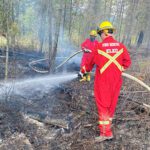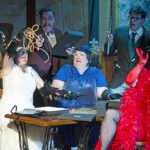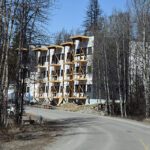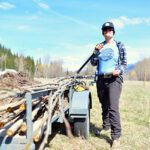Home »

Cadets take part in survival exercise
Cadets aged 12-18, from 552 Key City Royal Canadian Air Cadet Squadron recently participated in their annual Survival Field Training Exercise (FTX) at the Cranbrook District Rod and Gun Club.
Lessons included building fires and shelters, radio communication and ground signals.

On Saturday, cadets from Levels 3, 4, & 5, left on an afternoon hike. What they didn’t know when they left, was that they were not returning to base camp that night. To enhance the “Survival” portion of the FTX, when the cadets arrived at the pre-determined location, they were provided with a detailed scenario. They were told that they were on a flight from Calgary to Cranbrook when their plane lost power, communications, and an engine causing them to have a non airport landing (ie: plane crash).
Details included that they lost all radio communication, the weather was coming in fast; a search wouldn’t be launched until the next day. The group had figure out their priorities for survival, with limited resources and guidance by the supervising officer. In the morning, after cleaning up their camp, they realized that they would need to make some ground signals and hope a plane flies over.
This is where CASARA (Civil Air Search & Rescue) comes in.

Officers have been working with CASARA to plan a training exercise that would assist the cadet training and their training. Cadets began to make appropriate ground signals near their “crash site.” What they didn’t know, we had arranged for CASARA to fly over and try and spot the cadets.
The pilot and spotters were only told that they were looking for missing cadets and the approximate search area. Mr. Allister Pedersen came out to the site to observe the cadets in action and to watch the search. The plane made several passes, but they could not spot the cadets or their signals. The cadets moved to a larger clearing and when they spotted the plane, they began to use movement to help their chances of being seen.
Success – scarves, jackets and mirrors led to the seven cadets being seen. After returning to base, we led 16 junior cadets to an open field, to allow them a chance to be spotted by the search plane. They decided that the best ground signal they could make was an “X” and because they didn’t have any materials to use, they all laid down on the snow, in the shape of a giant X (lead image above). Unfortunately, they were not seen. When the plane was flying over again, they decided that it would be best to use movement to be spotted. They did it!
CASARA is a national non-profit volunteer organization that provides search and rescue assistance to the military and promotes flight safety.
Allister Pedersen, Cranbrook CASARA Training Officer, believes the joint exercises between Air Cadets and Air SAR are a perfect fit for both organizations. The exercises provide a great opportunity to educate prospective Cadet pilots on how to stay out of trouble and, if they are involved in an incident, what measures to take to attract the attention of CASARA crews conducting an air search. At the same time Air Cadets can learn of the opportunities to join CASARA (after they turn 19) and act as pilots, spotters, navigators or ground support.
For this exercise, CASARA members provided classroom training and field training involving the use of signaling mirrors, ground signals and other methods of attracting the attention of search aircraft. During the exercise CASARA air crews searched for the missing cadets and later discussed their use of signaling devices in a post-exercise debriefing.
During the debriefing, we viewed photos that were taken from the plane. It is amazing that either group was spotted, they look like boulders and logs in the photos. Cadets learned that it is not as easy to be located as they would think and that they may need more than one style of signaling style.
The squadron is really thankful to the Cranbrook District Rod and Gun Club and all of the people assisting from CASARA with our training weekend.
Submitted by Captain Lori-Lee Bott, Unit Public Affairs Representative, Kootenay Zone, Canadian Armed Forces







